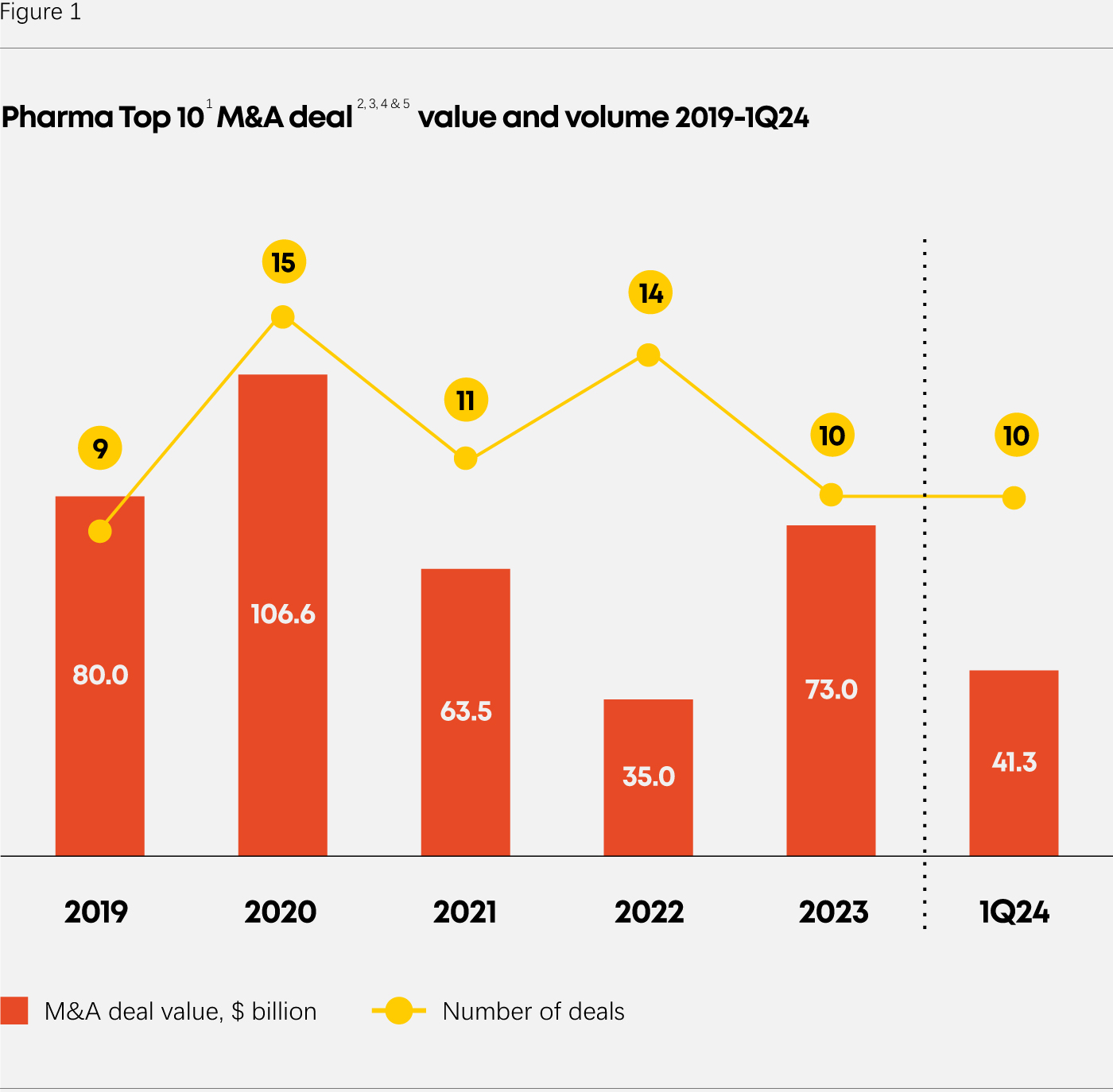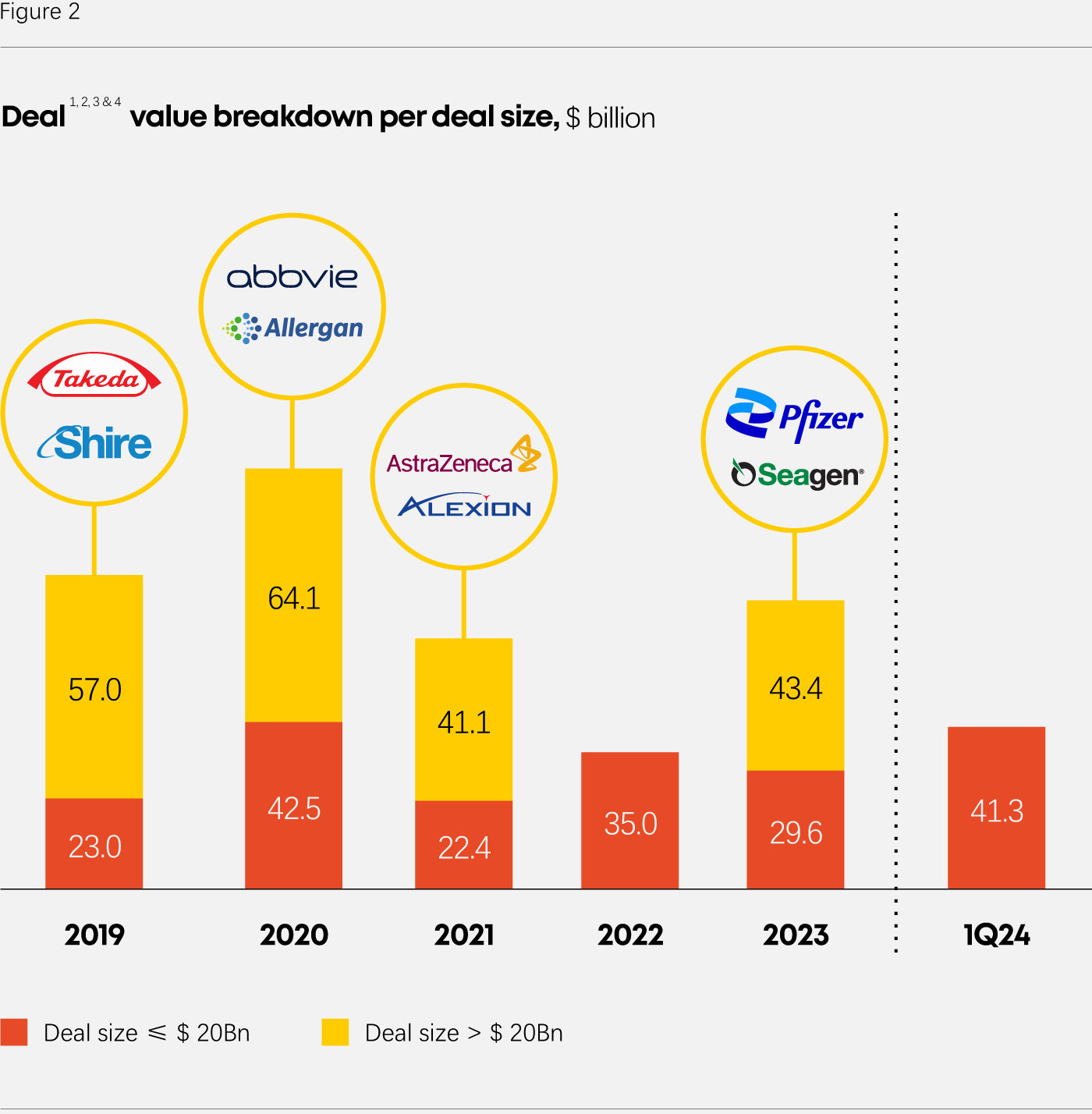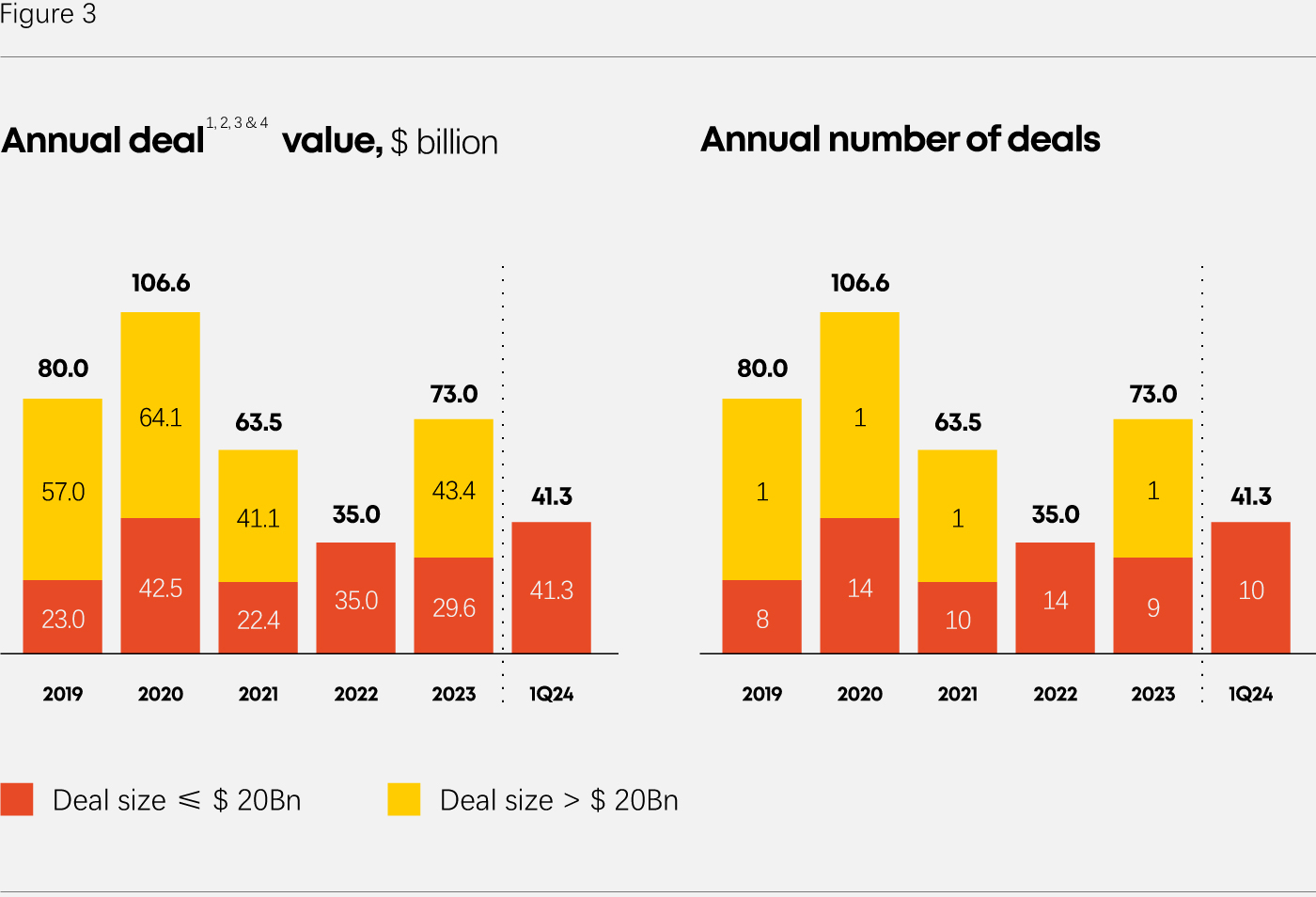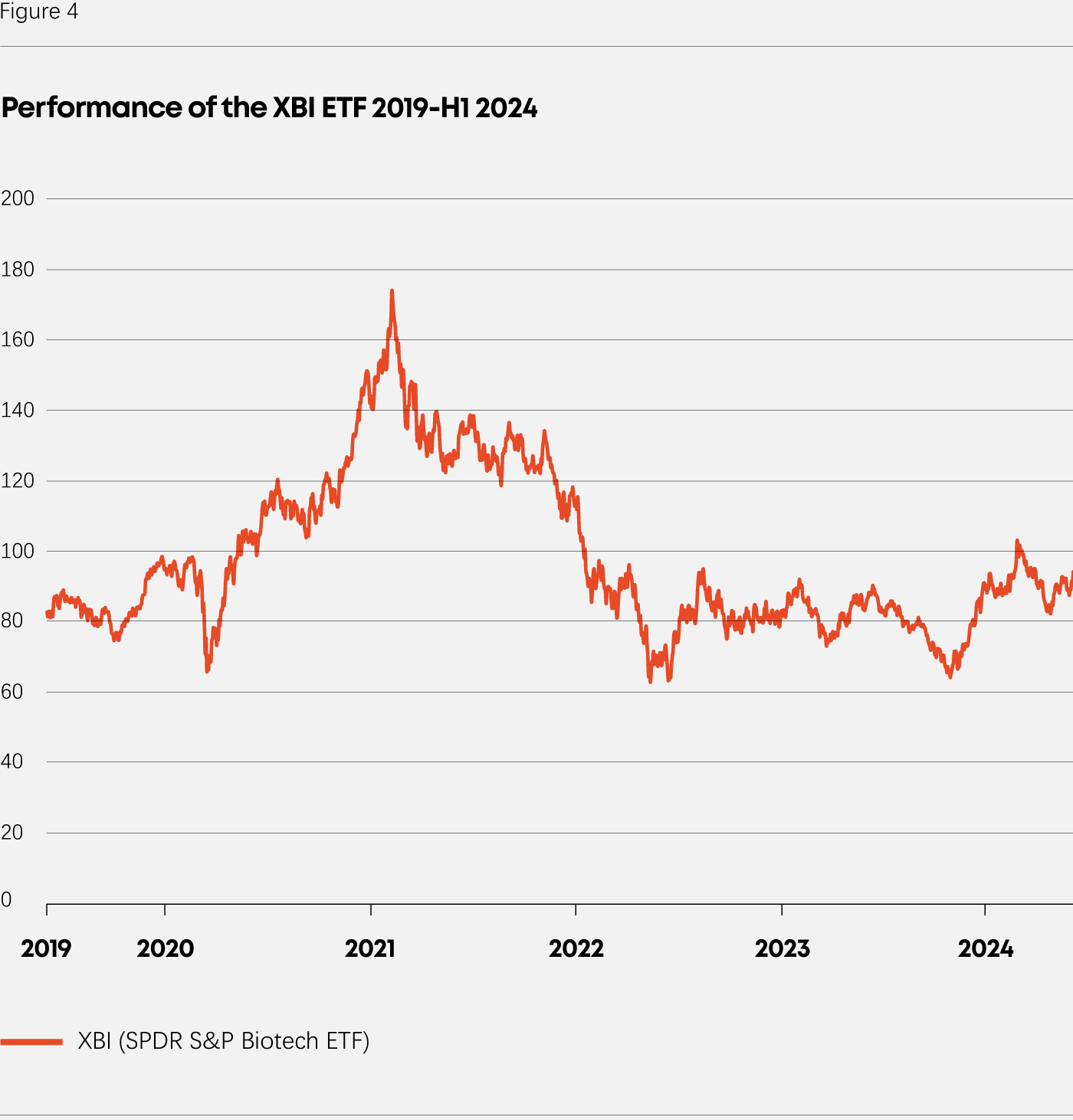With revenue challenges lying ahead and plenty of cash available, Pharma top 10 is expected to increasingly turn towards M&A to secure growth in the future.
KEY TAKEAWAYS
- Total deal value plummeted in 2021 and top 10 Pharma companies held back on big deal making in 2022 amidst uncertain markets.
- But under $20 billion transactions were already back on the menu in 2022 despite challenging macroeconomics, indicating a moderate impact of Covid, inflation and rising interest rates on mid-size deals.
- A remarkably high pace of transactions recorded in the first quarter of 2024 confirmed the renewed appetite for M&A deal making hinted in 2023.
- Top Pharma’s buying surge and Fed's announcement to cut interest rates by the end of 2024 has helped reverse Biotech stocks’ downtrend, illustrating a broader recovery of the Biotech sector since post-pandemic correction.
- Appetite for innovative technologies and strategic acquisitions is expected to continue in 2024 and beyond.
- Leading Pharma have billions in firepower to deploy and need to secure inorganic growth as they face revenue challenges brought by looming patent cliff and IRA price negotiations.
M&A trends from 2019 to 2024
Overall deal value plummeted following mid-pandemic peak
Though the pandemic shook the economic system in early 2020, M&A deal value and volume (Figure 1) still went up that year compared to 2019. Total deal value peaked at $106.6 billion with 15 transactions—including the acquisition of Allergan by AbbVie for $64.1 billion (Figure 2).

1. Top 10 Pharma based on Pharma sales for each year (excluding diagnostic, medical device, nutrition, etc.). 2023 Top 10 Pharma includes Pfizer, AbbVie, J&J, Novartis, Merck & Co, Roche, BMS, AstraZeneca, Sanofi and GSK vs. 2019 Top 10 Pharma includes Roche, Novartis, Pfizer, Merck & Co, Bayer, J&J, Sanofi, AbbVie, GSK and Takeda.
2. Deals closed/completed based on announcement in annual reports.
3. Deal value is the purchased price mentioned in annual reports.
4. M&A deals focusing on Pharma (excluding diagnostic, medical device, etc.).
5. Only M&A Buy-Out (excluding partial equity investment).
The 2020 peak can be attributed to the growth established in Pharma over the previous years, as well as the closing of several deals that had already been initiated back in 2019. The sector’s momentum and built-up growth kept deal value and volume on the uprise despite the broader economic challenges.
Deal value and volume only began to decline in 2021 (Figure 1), as the pandemic brought global M&A activity to a virtual halt.
Moderate impact of Covid on mid-size deals
In 2022, total deal value hit a low of $35 billion, a figure significantly impacted by the absence of any megadeals that year as they account for at least 60% of deal value each year (Figure 2). But while top 10 Pharma held back on big deal making, mid-size acquisitions were back on the menu big time that year despite macroeconomics with 14 transactions under $20 billion—equalling 2020 volume peak, excluding megadeals (Figure 3).
With a record-breaking $100.3 billion revenue in 2022—including $37.8 billion generated by its Comirnaty COVID-19 vaccine [1]—pandemic’s big winner initiated the return of mid-size transactions with 3 deals completed in 2022 and subsequently of megadeals in 2023 with the acquisition of Seagen for $43.4 billion (Figure 2).

1. Deals closed/completed based on announcement in annual reports.
2. Deal value is the purchased price mentioned in annual reports.
3. M&A deals focusing on Pharma (excluding diagnostic, medical device, etc.).
4. Only M&A Buy-Out (excluding partial equity investment).
Outstanding M&A deal making pace in Q1 2024
An uptick in deal making confirmed in the first quarter of 2024, as Big Pharma embraced a remarkably high pace of M&A activity (Figure 3).
Deal volume recorded in Q1 2024 was as much as in the entirety of 2023. Reaching $41.3 billion, and with no megadeals recorded yet, Q1 2024 transaction value alone has already surpassed those of 2019, 2021, 2022, and 2023—excluding megadeals.

1. Deals closed/completed based on announcement in annual reports.
2. Deal value is the purchased price mentioned in annual reports.
3. M&A deals focusing on Pharma (excluding diagnostic, medical device, etc.).
4. Only M&A Buy-Out (excluding partial equity investment).
Consequently, the upswing in deal making fueled by Big Pharma's end-of-year shopping spree—coupled with Fed's announcement to cut interest rates by the end of 2024—has helped reverse the downtrend in Biotech stocks.
While expected to range for the remainder of 2024, XBI (ETF tracking Biotech companies) rose by over 60% from its recent lows in October 2023 to reach a two-year high in March 2024—illustrating a broader recovery of the Biotech sector (Figure 4) since the post-pandemic correction.

Outlook for 2024 and beyond
Big Pharma's appetite for strategic acquisitions is expected to continue in 2024 and beyond. With plenty of capital available for M&A, top 10 drugmakers are striving to secure inorganic growth to address upcoming revenue challenges, including looming patent cliff and concerns related to the Inflation Reduction Act (IRA).
Looming patent cliff
To replace the hundreds of billions in lost revenue estimated from patents set to expire by 2030, developing innovative drugs and address new market opportunities through M&A will remain a top priority for Big Pharma.
Merck’s KEYTRUDA ($25 billion sales generated in 2023 [2]) and BMS’ ELIQUIS and OPDIVO (respectively $12.2 billion and $9 billion sales generated in 2023 [3]) represent some of the largest drugs facing patent expiration, positioning both to be especially poised for strategic M&A deal making in the coming years.
Inflation Reduction Act (IRA)
Pharma companies are also concerned about U.S. government price negotiations under Joe Biden’s IRA and its potential impact on future revenue. In response to these new financial pressures, top 10 Pharma could intensify strategic M&A to secure inorganic growth and mitigate financial pressure.
Billions in firepower for M&A
Top 10 Pharma companies continued to generate robust revenue during the pandemic, resulting in strong balance sheets and plenty of capital available for M&A.
Holding cash and cash equivalents of almost $100 billion at the end of 2023 [4]—a 14% increase compared to 2022, and the first YoY rise since 2019—Pharma will most likely make use of that firepower to secure growth and value in the future.
[1] Source: Pfizer annual report
[2] Source: Merck annual report
[3] Source: Bristol-Myers Squibb annual report
[4] Source: Annual reports
LATEST INSIGHTS
The Drug Modality and Therapeutic Area Trends of 2024